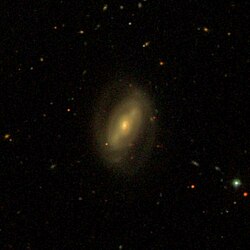| NGC 4003 | |
|---|---|
 SDSS image of NGC 4003. | |
| Observation data (J2000 epoch) | |
| Constellation | Leo |
| Right ascension | 11h 57m 59.0s [1] |
| Declination | 23° 07′ 30″ [1] |
| Redshift | 0.021848 [1] |
| Heliocentric radial velocity | 6550 km/s [1] |
| Distance | 305 Mly (93.6 Mpc) [1] |
| Apparent magnitude (V) | 14.28 [1] |
| Absolute magnitude (B) | -22.89 [1] |
| Characteristics | |
| Type | SB0 [1] |
| Mass | 4.8 × 1010 [2] M☉ |
| Size | ~183,100 ly (56.13 kpc) (estimated) [1] |
| Apparent size (V) | 1.5′ × 0.9′ [1] |
| Other designations | |
| UGC 06948, CGCG 127-115, MCG +04-28-105, PGC 037646 [1] | |
NGC 4003 is a barred lenticular galaxy located 305 million light-years away [3] in the constellation Leo. It was discovered on April 10, 1785, by astronomer William Herschel. [4] NGC 4003 forms a pair with the galaxy NGC 4002 known as [T2015] nest 102886, [5] and is part of the Coma Supercluster. [6]
Contents
NGC 4003 has a triple-ringed structure. It has a nucleus with a ringlike structure with dust lanes inside it, a strong bar surrounded by a second ring which is connected to broad spiral arms, and a nearly complete outer ring. It is thought the structure of NGC 4003 is a result of past interaction with NGC 4002. [4]
NGC 4003 is a LINER galaxy, [7] [8] with star formation dominating its nucleus, [7] and is host to a supermassive black hole with an estimated mass of 9.6 × 108 M☉. [9]